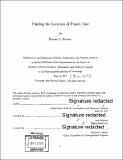| dc.contributor.advisor | Jack Wisdom. | en_US |
| dc.contributor.author | Downey, Brynna G | en_US |
| dc.contributor.other | Massachusetts Institute of Technology. Department of Earth, Atmospheric, and Planetary Sciences. | en_US |
| dc.date.accessioned | 2018-03-12T19:29:40Z | |
| dc.date.available | 2018-03-12T19:29:40Z | |
| dc.date.copyright | 2016 | en_US |
| dc.date.issued | 2017 | en_US |
| dc.identifier.uri | http://hdl.handle.net/1721.1/114095 | |
| dc.description | Thesis: S.B., Massachusetts Institute of Technology, Department of Earth, Atmospheric, and Planetary Sciences, June 2017. | en_US |
| dc.description | Cataloged from PDF version of thesis. | en_US |
| dc.description | Includes bibliographical references (page 19). | en_US |
| dc.description.abstract | To find Planet Nine, we use N-body simulations to find the true anomaly of Planet Nine that would render distant KBOs the most stable. We obtain an interval of 162-198°matching the intervals given by Medvedev & Vavilov (2016) of 176-184° and Brown & Batygin (2016) of 180°. According to our results, Planet Nine should reside in the constellation Lepus. | en_US |
| dc.description.statementofresponsibility | by Brynna G. Downey. | en_US |
| dc.format.extent | 19 pages | en_US |
| dc.language.iso | eng | en_US |
| dc.publisher | Massachusetts Institute of Technology | en_US |
| dc.rights | MIT theses are protected by copyright. They may be viewed, downloaded, or printed from this source but further reproduction or distribution in any format is prohibited without written permission. | en_US |
| dc.rights.uri | http://dspace.mit.edu/handle/1721.1/7582 | en_US |
| dc.subject | Earth, Atmospheric, and Planetary Sciences. | en_US |
| dc.title | Finding the location of Planet Nine | en_US |
| dc.title.alternative | Finding the location of Planet 9 | en_US |
| dc.type | Thesis | en_US |
| dc.description.degree | S.B. | en_US |
| dc.contributor.department | Massachusetts Institute of Technology. Department of Earth, Atmospheric, and Planetary Sciences | |
| dc.identifier.oclc | 1027220562 | en_US |
